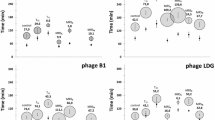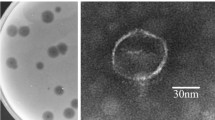Abstract
This study aims at assessing the influence of Pseudomonas fluorescence cell morphology on the effectiveness and production of the lytic bacteriophage ϕIBB-PF7A. P. fluorescens were cultured as rods or as elongated cells by varying the temperature and rotary agitation conditions. Cells presented rod shape when grown at temperatures up to 25°C and also at 30°C under static conditions, and elongated morphology only at 30°C when cultures were grown under agitation. Elongated cells were 0.4 up to 27.9 μm longer than rod cells. Rod-shaped hosts were best infected by phages at 25°C which resulted in an 82% cell density reduction. Phage infection of elongated cells was successful, and the cell density reductions achieved was statistically similar (P > 0.05) to those obtained at the optimum growth temperature of P. fluorescens. Phage burst size varied with the cell growth conditions and was approximately 58 and 153 PFU per infected rod and elongated cells, grown at 160 rpm, at 25°C (the optimal temperature) and 30°C, respectively. Phage adsorption was faster to elongated cells, most likely due to the longer length of the host. The surface composition of rod and elongated cells is similar in terms of outer membrane proteins and lipopolysaccharide profiles. The results of this study suggest that the change of rod cells to an elongated morphology does not prevent cells from being attacked by phages and also does not impair the phage infection.



Similar content being viewed by others
References
Adams MH (1959) Bacteriophages. Interscience Publishers, New York
Barry G, Goebel W (1951) The effect of chemical and physical agents on the phage receptor of phase-II Shigella sonnei. J Exp Med 94:387–400
Bremer H, Dennis PP (1996) Modulation of chemical composition and other parameters of the cell by growth rate. In: Neidhardt FC, Curtiss R III, Ingraham JL, Lin ECC, Low KB, Magasanik B, Reznikoff WS, Riley M, Schaechter M, Umbarger HE (eds) Escherichia coli and Salmonella: cellular and molecular biology. American Society for Microbiology, Washington, DC, pp 1553–1569
Comeau AM, Tetart F, Trojet SN, Prere M-F, Krisch HM (2007) Phage-antibiotic synergy (PAS): B-lactam and quinolone antibiotics stimulate virulent phage growth. PLoS ONE 2:e799
Edgar R, Rokney A, Feeney M, Semsey S, Kessel M, Goldberg MB, Adhya S, Oppenheim AB (2008) Bacteriophage infection is targeted to cellular poles. Mol Microbiol 68:1107–1116
Errington J, Daniel RA, Scheffers DJ (2003) Cytokinesis in bacteria. Mol Biol Rev 67:52–65
Greenwood D, O’Grady F (1973) Comparison of the response of Escherichia coli and Proteus mirabilis to seven b-lactam antibiotics. J Infect Dis 128:1231–1240
Hadas H, Einav M, Fishov I, Zaritsky A (1997) Bacteriophage T4 development depends on the physiology of its host Escherichia coli. Microbiology 143:179–185
Kasman L, Kasman A, Westwater C, Dolan J, Schmidt M, Norris J (2002) Overcoming the phage replication threshold: a mathematical model with implications for phage therapy. J Virol 76:557–5564
Krueger AP, Cohn T, Smith PN, McGuire CD (1948) Observations on the effect of penicillin on the reaction between phage and staphylococci. J Gen Physiol 31:477–488
Laemmli UK (1970) Cleavage of structural proteins during the assembly of the head of bacteriophage T4. Nature 227:680–685
Maki N, Gestwicki JE, Lake EM, Kiessling LL, Adler J (2000) Motility and chemotaxis of filamentous cells of Escherichia coli. J Bacteriol 182:4337–4342
Margolin W (2000) Themes and variations in prokaryotic cell division. FEMS Microbiol Rev 24:531–548
Maskell JP (1991) The resolution of bacteroides lipopolysaccharides by polyacrylamide-gel electrophoresis. J Med Microbiol 34:253–257
Masuda N, Sakagawa E, Ohya S (1995) Outer membrane proteins responsible for multiple drug resistance in Pseudomonas aeruginosa. Antimicrob Agents Chemother 39:645–649
Puig A, Araujo R, Jofre J, Frias-Lopez J (2001) Identification of cell wall proteins of Bacteroides fragilis to which bacteriophage B40-8 binds specifically. Microbiology 147:281–288
Rolinson GN (1980) Effect of b-lacta antibiotics on bacterial cell growth rate. J Gen Microbiol 120:317–323
Rothfield LS, Justice S, Garcia-Lara J (1999) Bacterial cell division. Annu Rev Genet 33:423–448
Sambrook J, Russell DW (2001) Molecular cloning: a laboratory manual. Cold Spring Harbor Laboratory Press, Cold Spring Harbor, NY
Sillankorva S, Neubauer P, Azeredo J (2008) Isolation and characterization of a T7-like lytic phage for Pseudomonas fluorescens. BMC Biotechnol 8:80
Sillankorva S, Neubauer P, Azeredo J (2008) Pseudomonas fluorescens biofilms subjected to phage phiIBB-PF7A. BMC Biotechnol 8:79
Sillankorva S, Neubauer P, Azeredo J (2010) Phage control of dual species biofilms of Pseudomonas fluorescens and Staphylococcus lentus. Biofouling 26:567–575
Steinberger RE, Allen AR, Hansa HG, Holden PA (2002) Elongation correlates with nutrient deprivation in Pseudomonas aeruginosa—unsaturated biofilms. Microbiol Ecol 43:416–423
Werner E, Roe F, Bugnicourt A, Franklin MJ, Heydorn A, Molin S, Pitts B, Stewart PS (2004) Stratified growth in Pseudomonas aeruginosa biofilms. Appl Environ Microbiol 70:6188–6198
Wright JB, Costerton JW, Mccoy WF (1988) Filamentous growth of Pseudomonas aeruginosa. J Ind Microbiol 3:139–146
Yokochi T, Narita K, Morikawa A, Takahashi K, Kato Y, Sugiyama T, Koide N, Kawai M, Fukada M, Yoshida T (2000) Morphological change in Pseudomonas aeruginosa following antibiotic treatment of experimental infection in ice and its relation to susceptibility to phagocytosis and to release of endotoxin. Antimicrob Agents Chemother 44:205–206
You LC, Suthers PF, Yin J (2002) Effects of Escherichia coli physiology on growth of phage T7 in vivo and in silico. J Bacteriol 184:1888–1894
Young KD (2006) The selective value of bacterial shape. Microbiol Mol Biol Rev 70:660–703
Young KD (2007) Bacterial morphology: why have different shapes? Curr Opin Microbiol 10:596–600
Acknowledgments
This work was supported by a grant (SFRH/BD/18485/2004) from the Portuguese Foundation for Science and Technology (FCT).
Author information
Authors and Affiliations
Corresponding author
Rights and permissions
About this article
Cite this article
Sillankorva, S., Pires, D., Oliveira, H. et al. The Influence of P. fluorescens Cell Morphology on the Lytic Performance and Production of Phage ϕIBB-PF7A. Curr Microbiol 63, 347 (2011). https://doi.org/10.1007/s00284-011-9987-0
Received:
Accepted:
Published:
DOI: https://doi.org/10.1007/s00284-011-9987-0




